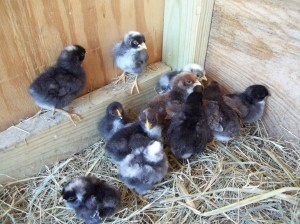The date had past for the eggs to hatch in the incubator and I waited a couple more days just to be sure. Then one of the four eggs hatched so I waited a couple more days. I wanted to put more eggs in the incubator and start a new batch so I took the the remaining three eggs out.
Two of the eggs felt heavy like there were chicks inside so I carefully hit the fat end of the egg enough to make a small crack and then peeled it open until I could see the beak. The large end of the egg is where the head will be and it will start pecking or zipping it’s way out. I made a big enough hole so the chick could get air and put it back into the incubator. I could see it was alive because there was throbbing of the skin and the beak was moving.
The second egg pretty much went the same way…live chick, not ready to be hatched so I put it back in the incubator after assuring myself that the chick could get air. The membrane inside the shell is sometimes soft if there is a lot of moisture and then looks like paper if it is dryer in the incubator. Then there seems to be another clear membrane that can shrink wrap the chick if there is not enough moisture.
I was really glad I opened the second egg because I think the chick was in there so tightly that it might not have been able to move around to zip out of the egg. I have opened a couple eggs after the due date had past and there was a perfectly healthy chick in there dead. I can only assume the chick could not get out and the air pocket was gone. Who knows?
I have opened many eggs and the chicks have survived. I left the two chicks for a day and the chicks had not tried to get out of the shell. I opened the shell carefully so I could see the chicks bottom but yet not pull it out of the shell and disconnect it. I could see there was some yellow yoke that had not been absorbed into the chick yet so I knew I needed to leave the chick alone for another day. Which is what I did.
So the next day, I carefully checked the yoke sac and it was gone so I removed the chick and carefully cut the chick loose. I put a little flour on its bottom to assure it’s bottom didn’t stick to the material that I was going to lie it on. I put the chick under a heat lamp on a tshirt inside a small box and let it dry out. It wiggled alot and started drying itself off and was looking fluffy. After about twelve hours, I realized the heat lamp made the chick more like 105 instead of 99/100 and it looked distressed. I took some sugar water and a straw and slowly gave it a sip of water. It’s head was rather limp and it was acting really weak. So sad. But, much to my delight, an hour later the chick was trying to stand up and seemed much stronger.
I have since put the chick outside with another momma hen who just hatched a baby chick two days ago. I try to get the chick with a momma right away. When I have kept a chick by herself, it died.
The second chick is still in the incubator. I will wait and see when the yoke is absorbed before I take any further steps.
So, don’t be afraid to help the chick out of the shell. Be sure to keep the chick really warm…about 99/100 degrees. If there is any bleeding or gooey stuff on its bottom, be sure and use flour to stop the moist end from sticking to any material. If it starts to pull away and wiggle around and it sticks, it could make it bleed more and there isn’t that much blood in a small chick.
Good luck with your baby chicks. They are a joy.
